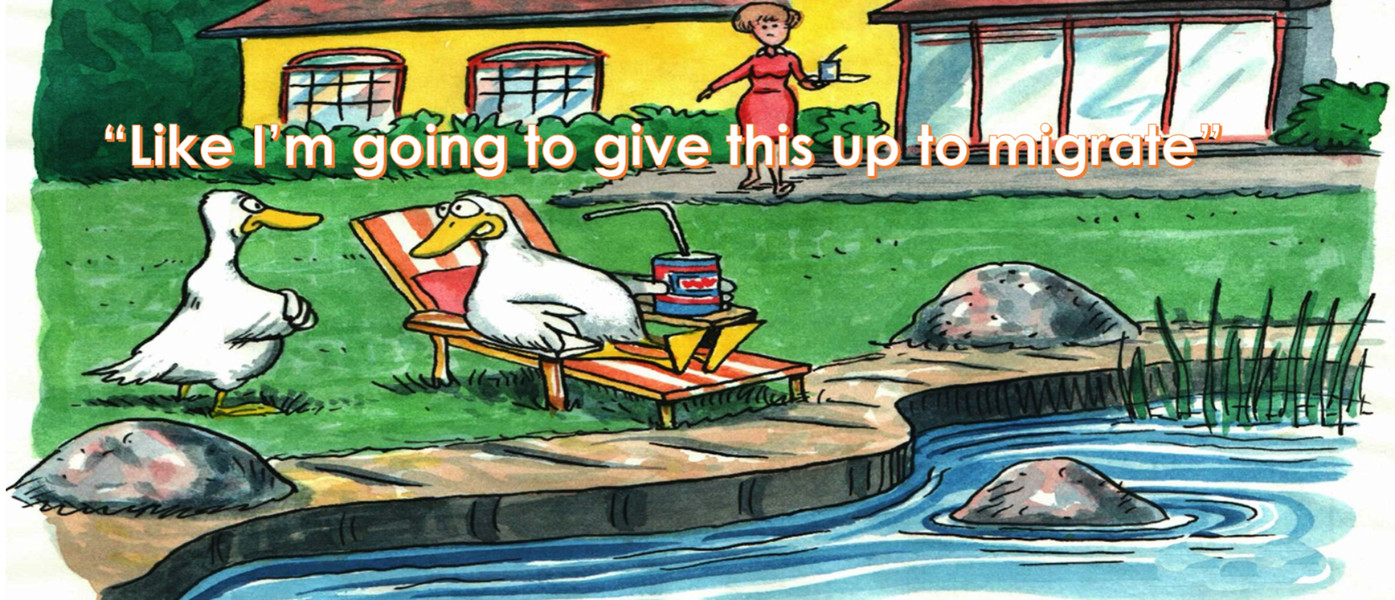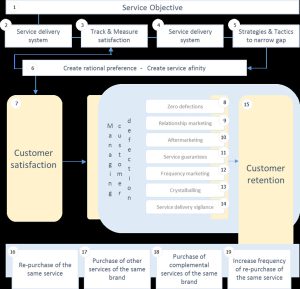19 Proven Steps to Stop Customer Defection

Pre-emptive effort!
Customer migration management is a pre-emptive whole-of-business effort to engage systems and behaviors that constantly inform management when a customer stops buying in favor of a competitor and the reasons why, so that it is better positioned to avert future defections.
In instances where your business deals mainly with intangible products, a zero defection policy is required in formulating your service objectives and should underpin your service-delivery system. In so doing, your business will gather intelligence about its existing customer base to develop and implement cost-effective strategies to retain and grow customers of value.
Management strategies to manage customer defection and retention vary subject to the size, culture, and type of the service business. That being said, in my view, the following service delivery funnel captures how the three dimensions of (a) business service objective, (b) customer satisfaction, and (c) customer retention should be fundamentally integrated to achieve and sustain the ultimate service delivery reward.

In instances where your business deals mainly with intangible products, a zero defection policy is required in formulating your service objectives and should underpin your service-delivery system. In so doing, your business will gather intelligence about its existing customer base to develop and implement cost-effective strategies to retain and grow customers of value.
Management strategies to manage customer defection and retention vary subject to the size, culture, and type of the service business. That being said, in my view, the following service delivery funnel captures how the three dimensions of (a) business service objective, (b) customer satisfaction, and (c) customer retention should be fundamentally integrated to achieve and sustain the ultimate service delivery reward.
Create service objectives that attract
Step 1- the business needs to articulate its service objectives in terms of:
- The type of customers it wishes to retain.
- The profitable margins and purchase frequency required to justify a retention effort.
- The service intentions it wishes its customers to buy.
Step 2 – the business needs to engineer its service delivery system so that it is capable of delivering its service objectives.
Step 3 – the business needs to track and measure customer satisfaction. This can be readily done by implementing manual and digital complaint and suggestion systems, actively engaging satisfaction surveys and questionnaires, focus groups and mystery shopping existing and past customers. All these external measures must be supported by internal transactional records such as take up of discount vouchers, refund registers, and invoice payment patterns.
Step 4 – qualitative and quantitative analysis of customer satisfaction measures needs to be carried out by objectively comparing the business’ service objectives with how they have been perceived by customers during the service delivery process. This critical examination of service performance also needs to be enhanced by a critical evaluation of the customers that the business wishes to retain so that resources can be better directed at those who produce the most sustained value.
Step 5 – the customer-centric business ought to respond quickly to any identifiable service delivery gaps by developing strategies and tactics to narrow, if not to eliminate these gaps. These may include such things as staff training, product improvements, and pricing strategies.
Step 6 – subject to the effectiveness of the tactics deployed to narrow the service delivery gap, the business may deliver differentiated services and create rational preference. If this is not achieved, then Steps 3, 4 and 5 need to be revisited.
Implement strategies that satisfy
Step 7 – the successful fusion of Steps 1 to 6 equates to customer satisfaction where service delivery efforts amount to more than offering the right product at the right price. That is, a point along the business’s service-intentions and customers value-perception continuum where the business is comfortable to operate in order to maximise shareholders’ value.
Step 8 – the business engages one of the many strategies to pro-actively manage customer defection and retention. I would argue that the creation of customer loyalty begins with the adoption of a zero defection policy. This essentially mandates a whole-of-business alignment of service objectives and the implementation of systems and procedures to track and analyse information about existing customers so that retention strategies can be more effectively developed and implemented as detailed in Steps 9 to 14. Failure to arrest defection is costly. It undermines critical-mass and places the business at the resource intensive Steps 1 and 2 of the customer-relationship continuum.
Step 9 – services relationship marketing is a construct that is founded on two key premises:
- Products generate profits, good customer relationships generate wealth.
- The intangibility and inseparability characteristics of services mean that the business must focus on affective and calculative commitment among every link along its supply chain. This entails such strategies as the hiring, training, empowering and rewarding of service personnel as wells as the selection of suppliers not just on the basis of product and price alone.
Step 10 – after-marketing efforts support the notion that the customer is far more important after than during a sale. These may include:
- Satisfaction surveys.
- Discretionary efforts such as birthday cards, thank you notes and an unexpected gift.
- Just-in-time marketing that targets customers’ buying cycle.
- Responding in a timely fashion to post-purchase complaints even the non-instrumental ones.
- Targeted public relation events and sponsorships.
- Incentives to satisfied customers to recommend their experience to others.
Step 11 – service guarantees go to the root of alleviating a customer’s perception of purchase risks, especially when it comes to intangible products. They are effective in attracting and converting new customers as well as encouraging re-purchase decisions before the expiry of the guarantee. The guarantee, especially if it is unconditional creates a psychological commitment to the brand and contributes to retention.
Step 12 – frequency marketing targets customers of value with the specific intention to get them to buy more of the same brand or extend their purchases across other brands within the company’s stable. This feeds directly in the importance of implementing a zero defection model at the outset that captures information how customers behave during and after the service delivery process. Initiatives such as loyalty programs, product innovation, discount cards, priority bookings, and services bundling bonuses.
Step 13 – the art of crystalballing is key to retaining customers and encouraging re-purchases. Service businesses have to be skilled at anticipating their customers’ future needs and be ahead of the market with their products and the way they are delivered.
Step 14 – service delivery vigilance is a big contributor to maximising retention rates. By building transparent quality control measures and the presence of supervising personnel throughout the service delivery process, the customer’s perception of service failure at the time and at another time in the future is reduced, thereby increasing the likelihood of a re-purchase.
Deploy tactics to retain and gain
Step 15 – the third dimension is manifested in customer loyalty which is where customers demonstrate more than a rational preference for the service but actually possess emotional attachment to the brand itself. It is a culmination of the resolve of a business to commit to Steps 1 to 14 not just once but throughout the business’ life cycle.
Steps 16, 17, 18 and 19- the rewards filtered through the service delivery funnel as a result of relentlessly pursuing service objectives, customer satisfaction and customer loyalty are ultimately what every business should strive for:
- Re-purchase of the same service.
- Purchase of other services of the same brand.
- Increase in the frequency of purchases of all services.
- Purchase of complementary services of the same brand.
Dr Maurice Roussety is a Consulting Strategist for DST Advisory and Lecturer in Small Business, Franchising and Entrepreneurship at Griffith University in Queensland, Australia. He has worked with leading organisations such as Queensland Transport, IAG, Westpac, Australia Post, Coles Myer, Red Rooster, Commonwealth Bank, ACCC, and Optus. Maurice holds a PhD in Intellectual Property and Franchise Goodwill Valuation. He also holds a Master’s degree in Leadership and in Business Administration. He is available for consulting and public speaking engagements and can be contacted further at maurice@dstadvisory.com or you can visit him at www.mauriceroussety.com.au



